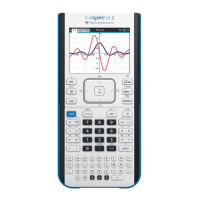20 TI-Nspire™ Reference Guide
cos(squareMatrix1) ⇒ squareMatrix
Returns the matrix cosine of squareMatrix1. This is not the same as
calculating the cosine of each element.
When a scalar function f(A) operates on squareMatrix1 (A), the
result is calculated by the algorithm:
Compute the eigenvalues (l
i
) and eigenvectors (V
i
) of A.
squareMatrix1 must be diagonalizable. Also, it cannot have symbolic
variables that have not been assigned a value.
Form the matrices:
Then A = X B X
/and f(A) = X f(B) X/. For example, cos(A) = X cos(B)
X/ where:
cos(B) =
All computations are performed using floating-point arithmetic.
In Radian angle mode:
cos
/
()
μ key
cos/(Va lu e1 ) ⇒ value
cos/(List1) ⇒ list
cos/(Va lu e 1) returns the angle whose cosine is Va l ue 1 .
cos/(List1) returns a list of the inverse cosines of each element of
List1.
Note: The result is returned as a degree, gradian or radian angle,
according to the current angle mode setting.
Note: You can insert this function from the keyboard by typing
arccos(...).
In Degree angle mode:
In Gradian angle mode:
In Radian angle mode:
cos/(squareMatrix1) ⇒ squareMatrix
Returns the matrix inverse cosine of squareMatrix1. This is not the
same as calculating the inverse cosine of each element. For
information about the calculation method, refer to cos().
squareMatrix1 must be diagonalizable. The result always contains
floating-point numbers.
In Radian angle mode and Rectangular Complex Format:
To see the entire result, press £ and then use ¡ and ¢ to
move the cursor.
cos()
μ key

